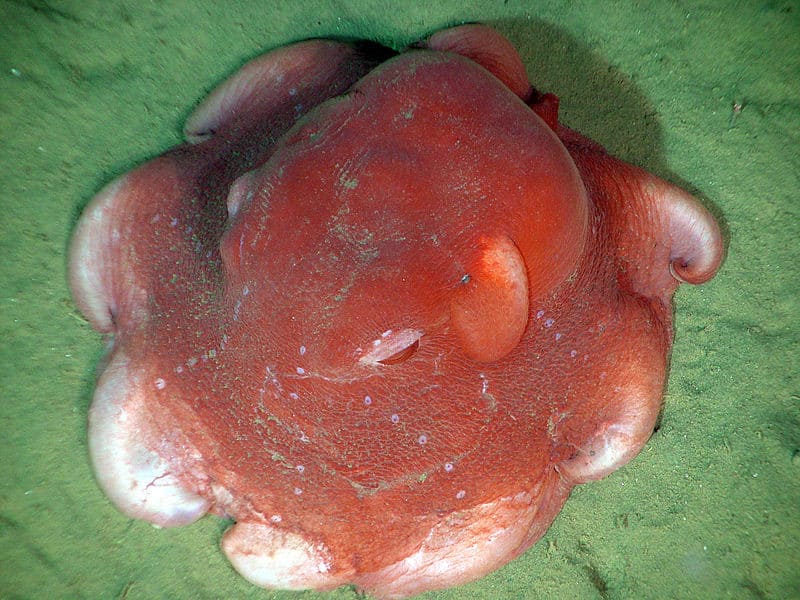Flapjack Octopus Facts
- This incredible example of the efforts of Nature and evolution most frequently goes by the common name of the Flapjack Octopus. Sometimes, however, individuals refer to it by the alternate common name of the adorabilis, for wholly understandable reasons.
- The distinctive common names for this wonder of Nature do not simply stop there, however. That’s because the Mollusc also has yet another name used to refer to it. All members of its genus are also collectively known sometimes as flapjack devilfishes.
- Professional researchers, meanwhile, typically refer to it by its scientific name. That’s the less descriptive, and certainly less pronounceable, term of Opisthoteuthis californiana. No matter which term one uses to refer to it, it has a unique appearance.
- The first scientific notation of this cephalopod as a separate and distinct species only took place in modern times. More precisely, it occurred in 1949. This event occurred as a direct result of the efforts of the American marine zoologist, Samuel Stillman Berry.
- For the moment, little specific data concerning its population and range exists. The IUCN, therefore, now lists it as Data Deficient on the organization’s Red List of Threatened Species. This umbrella octopus seems reluctant to yield its secrets!
- The Flapjack Octopus nonetheless likely faces the same potential threats as other species around the world. These include such factors as habitat loss or degradation, and commercial fishing practices. Climate change, however, is likely its greatest threat.
Related Articles
Flapjack Octopus Physical Description
The amazing Flapjack Octopus derives it most frequently used common name from its overall shape. That, as can be clearly seen here, consists of a flattened shape for the mantle. This surrounds a dome-shaped inner portion, though the body’s highly gelatinous in nature.
The cephalopod does not, however, impress one due to size, relying on its appearance for that. That holds true due to the fact that this species of umbrella octopus remains relatively tiny. In fact, individuals rarely attain a mantle length of more than 8 in (20 cm).
Unlikely many of its kindred, however, it displays no noticeable degree of the physiological characteristic of sexual dimorphism. That particular trait also distinguishes it from most known cephalopods. It’s a trait generally shared with the rest of its genus, though.
In color, the remarkable Flapjack Octopus typically appears primarily red. It does, however, often display small whitish portions along the edge of the mantle. Its eight jointed legs are fixed together, with the mantle itself strung between them, creating the umbrella appearance.
The small, but efficient eyes of this fascinating Mollusc develop affixed to the top of the bulbous head. Two small, wing-shaped structures also appear on the head, typically above the eyes. In this, the unique creature resembles some of the known varieties of squid.
- Kingdom: Animalia
- Phylum: Mollusca
- Class: Cephalopoda
- Order: Octopoda
- Family: Opisthoteuthidae
- Genus: Opisthoteuthis
- Species: O. californiana
Flapjack Octopus Distribution, Habitat, and Ecology
Unfortunately, the precise range of distribution for the marvelous Flapjack Octopus remains an uncertaim matter. That’s because it’s only been sighted in a few, widely separated locations. This likely further indicates a wide, perhaps even global, range of distribution.
It remains possible, however, that it once had a larger range, but now only exists in small populations in these few areas. For the moment, that’s just one more of the things science does not yet know with any certainty, where this particular creature is concerned.
One region where the animal’s been sighted lies off the coast of California, in the United States, in North America. The other known zones of habitation consists of the Bering Sea and the Sea of Okhotsk, along with a location just off the coast of central Honshu.
All reported sightings indicate it has a preference for open ocean, and at certain ranges of depths. The specimens observed appeared at depths ranging from 660 – 4,900 ft (200 -1,500 m). This generally places the animals in the benthic zone, near the ocean bottom.
It moves via a surprising combination of methods. These include, of course, pushing water through its jet, like most other related species. It does, however, also employ both its webbed arms, in a pulsing motion, as well as even using its flap-like fins atop the head!
Malesof the Flapjack Octopus appear to perform various rituals to attract the female. After mating, she usually produces between 200 – 500 eggs. After hatching, the young remain near their mother for a time, though, before swimming off to hopefully survive on their own.
Species Sharing Its Range
Check out our other articles on 3 Tantalizing Trees of Asia, Black-and-white hawk-eagle, New River, Kerengga ant-like jumper, Swamp Wallaby, Southern Stingray, Anegada ground iguana

